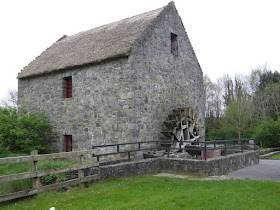
Song on a May Morning
Now the bright morning-star, day's harbinger,
Comes dancing from the east, and leads with her
The flowery May, who from her green lap throws
The yellow cowslip and the pale primrose.
Hail, bounteous May, that dost inspire
Mirth and youth and warm desire!
Woods and groves are thy dressing,
Hill and dale doth boast thy blessing.
Thus we salute thee with our early song,
And welcome thee, and wish thee long.
John Milton (1608-1674)
John Milton's best known work is 'Paradise Lost' but the lovely poem above was written when he was a student at Christ's College in Cambridge.

Come queen of months in company
Wi all thy merry minstrelsy
The restless cuckoo absent long
And twittering swallows chimney song
And hedge row crickets notes that run
From every bank that fronts the sun
And swathy bees about the grass
That stops wi every bloom they pass
From 'A Shepherd's Calendar' by John Clare

Sumer is i-cumin in,
Lhude sing, cuccu!
Groweth sed and bloweth med
And springth the wude nu.
Sing, cuccu!
Sing, cuccu!
Say the words out loud and they will make more sense:) These are the first few lines of the oldest known English part song, it was written in the mid 13th century.I can remember learning to sing it in music lessons at school when I was 12 or 13 years old. (The word 'sing' is used very loosely here!) It's written in Middle English, the language of Geoffrey Chaucer and The Canterbury Tales. In case you're struggling it translates:
Summer is a-coming in,
Loud sing,cuckoo!
Groweth seed and bloweth mead
And springs the wood anew.
Sing, Cuckoo!
Sing, Cuckoo!
Mead means meadow here, not the rather scrummy alcoholic drink made from honey!
I heard my first cuckoo yesterday morning - I was so pleased as I was worried that their falling numbers and the poor weather might mean that I wouldn't hear that wonderful herald of early summer this year.


When daisies pied and violets blue
And lady-smocks all silver-white
And cuckoo-buds of yellow hue
Do paint the meadows with delight
William Shakespeare
The lines are from 'Love's Labours Lost' and the photos show the 'daisies pied'. If you click on the second one to enlarge it you can see that the some of the daisies are pink and white which is what makes them 'pied'.
This is Beltane when the door to summer opens and all the beauty of vibrant new life awaits us in the merry month of May - hopefully with rather more in the way of blue skies and sunshine than we've seen lately:) For the ancient Celts the day ran from sunset to sunset which is why this post appears on the 30th April:) So onward we go for
The dust coloured cuckoo
Cries welcome O Queen!
For winter has vanished,
The thickets are green.





















































